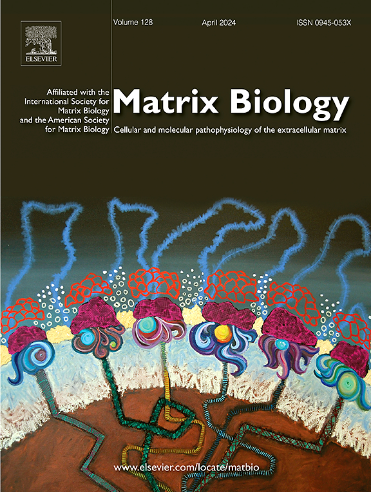Toward a rational therapeutic for elastin related disease: Key considerations for elastin based regenerative medicine strategies
IF 4.5
1区 生物学
Q1 BIOCHEMISTRY & MOLECULAR BIOLOGY
引用次数: 0
Abstract
Elastin is a connective tissue protein, produced from the ELN gene, that provides elasticity and recoil to tissues that stretch, such as the large arteries of the body, lung parenchyma, skin, ligaments and elastic cartilages. It is produced as a soluble monomer, tropoelastin, that when cross-linked in the extracellular space generates a polymer that is extraordinarily stable, with a predicted half-life of >70 years. Although data suggest ongoing elastin transcription, it is rare to see new elastin deposited outside of its tight developmental window. Consequently, elastin-related disease comes about primarily in one of three scenarios: (1) inadequate elastin deposition, (2) production of poor-quality elastic fibers, or (3) increased destruction of previously deposited elastin. By understanding the pathways controlling elastin production and maintenance, we can design new therapeutics to thwart those abnormal processes. In this review, we will summarize the diseases arising from genetic and environmental alteration of elastin (Williams syndrome, supravalvar aortic stenosis, autosomal dominant cutis laxa, and ELN-related vascular and connective tissue dysfunction) and then describe the mechanisms controlling elastin production and maintenance that might be manipulated to generate novel therapeutics aimed at these conditions. We will end by summarizing existing therapeutic strategies targeting these disease mechanisms before outlining future approaches that may better solve the challenges associated with elastin based regenerative medicine.
迈向弹性蛋白相关疾病的合理治疗:基于弹性蛋白的再生医学策略的关键考虑。
弹性蛋白是一种结缔组织蛋白,由 ELN 基因产生,可为人体大动脉、肺实质、皮肤、韧带和弹性软骨等伸展组织提供弹性和反冲力。它以可溶性单体特罗波弹性蛋白(tropoelastin)的形式产生,在细胞外空间交联后生成的聚合物异常稳定,半衰期预计超过 70 年。尽管有数据表明弹性蛋白的转录仍在进行,但很少能看到新的弹性蛋白在其紧密的发育窗口外沉积。因此,与弹性蛋白相关的疾病主要有三种情况:1)弹性蛋白沉积不足;2)产生劣质弹性纤维;或3)先前沉积的弹性蛋白破坏加剧。通过了解控制弹性蛋白生成和维持的途径,我们可以设计出新的疗法来阻止这些异常过程。在这篇综述中,我们将总结因弹性蛋白的遗传和环境改变而导致的疾病(威廉姆斯综合征、主动脉瓣上狭窄、常染色体显性遗传性皮肤松弛症以及与ELN相关的血管和结缔组织功能障碍),然后描述控制弹性蛋白生成和维持的机制,这些机制可能会被用于产生针对这些疾病的新型疗法。最后,我们将总结针对这些疾病机制的现有治疗策略,然后概述未来可能更好地解决弹性蛋白再生医学相关挑战的方法。
本文章由计算机程序翻译,如有差异,请以英文原文为准。
求助全文
约1分钟内获得全文
求助全文
来源期刊

Matrix Biology
生物-生化与分子生物学
CiteScore
11.40
自引率
4.30%
发文量
77
审稿时长
45 days
期刊介绍:
Matrix Biology (established in 1980 as Collagen and Related Research) is a cutting-edge journal that is devoted to publishing the latest results in matrix biology research. We welcome articles that reside at the nexus of understanding the cellular and molecular pathophysiology of the extracellular matrix. Matrix Biology focusses on solving elusive questions, opening new avenues of thought and discovery, and challenging longstanding biological paradigms.
 求助内容:
求助内容: 应助结果提醒方式:
应助结果提醒方式:


